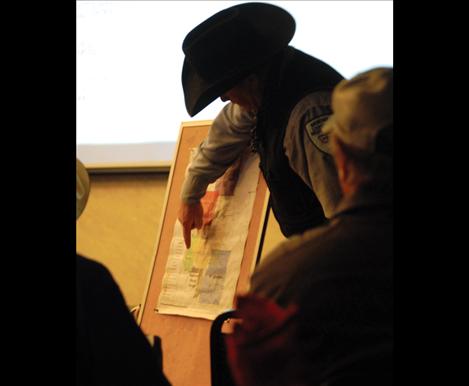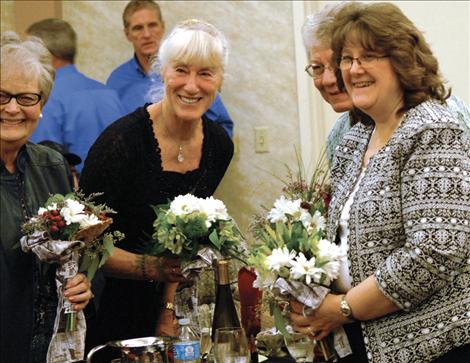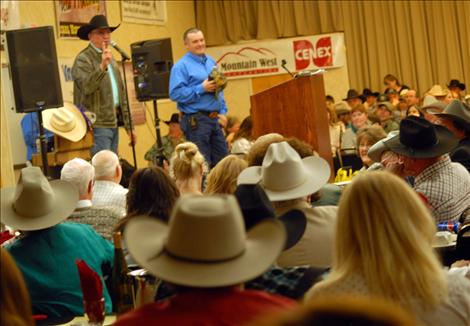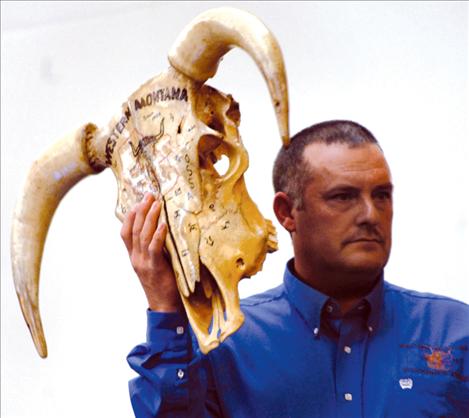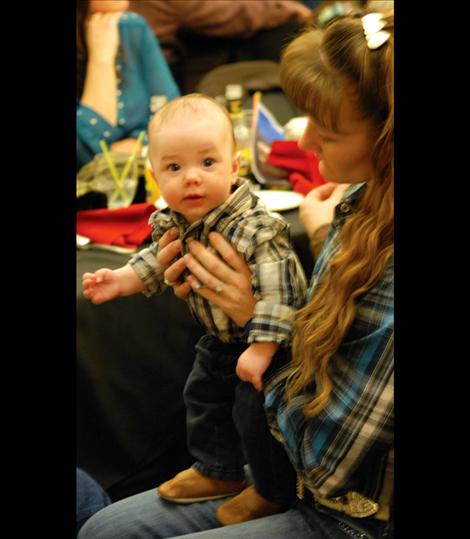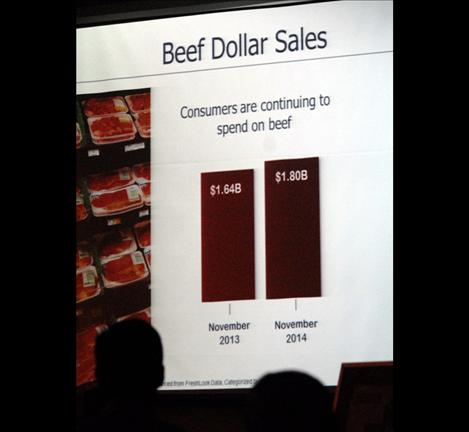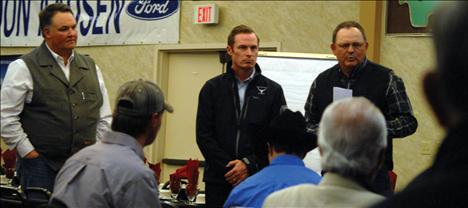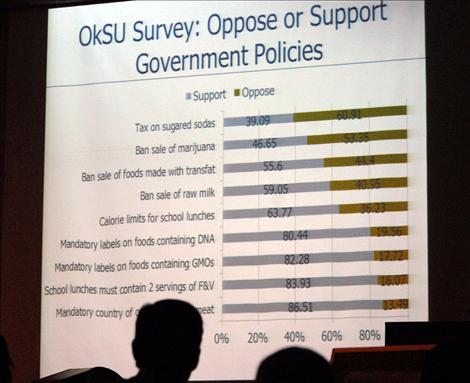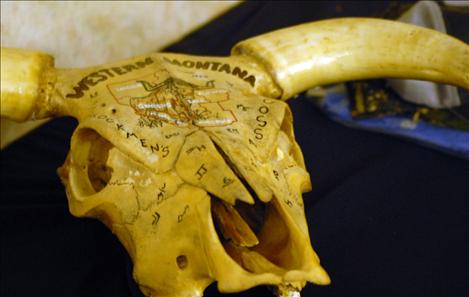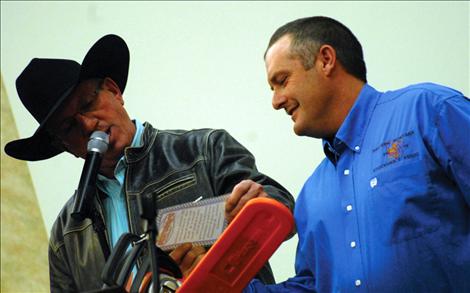Ranchers gather for winter stockgrowers’ meeting
Hey savvy news reader! Thanks for choosing local.
You are now reading
1 of 3 free articles.
The lower floor of the KwaTaqNuk Resort and Casino was awash with ranching men and ladies Saturday as the Western Montana Stockgrowers Association held their winter meeting.
The WMSA presented their Lifetime Achievement Award to the Western Montana Cattlewomen. They were active for roughly 50 years, according to Ken McAlpin, WMSA director.
Louise Melton was instrumental in getting the group going in 1958 and was their first president in 1959, when they called themselves the Cow Belles.
Cattlewomen’s projects ranged from beef cook-offs, sending young couples to the state livestock convention, selling hamburgers at Homesteader’s Days in Hot Springs, and publishing an all-beef cookbook to making brand books and brand blankets.
McAlpin said the WMSA wanted to honor Judy Herman, who passed away in December 2014. She was the group’s 10th president and always very active in the organization.
The cattlewomen disbanded in 2008 and bequeathed their treasury to the WMSA, who currently use the money for a goodwill fund. The fund has paid for traveling money for World War II veterans to reach their Honor Flight, heifers for South Dakota after the horrific blizzard in 2013, the Hot Springs Medical Clinic fundraiser, and $1,000 worth of hamburger for local foodbanks.
Guest speaker Rachel Endecott, Montana State University extension beef cattle specialist, talked about educating people who are not in the cattle business, and results of researching consumers. She said consumers want beef and are willing to spend more for it, “with quality trumping price at retail,” she said.
As far as an industry outlook for cattle raisers, Endecott had several points. The United States has its smallest cowherd since 1941, and the demand for beef is strong.
Noting that herd rebuilding may take a few years, Endecott said the good news is economists suggest high beef prices will remain for the next several years.
During the business meeting, U.S. Department of Agriculture Wildlife Services supervising wildlife biologist Craig Glazier addressed a common concern for ranchers — predators.
Two mountain lions were harvested this year, compared to 10 last year; 30 wolves were killed last year and 18 this year, according to Glazier.
Livestock predation damages, reported and verified, were $128,000 last year, down from almost $200,000 the year before.
Glazier also noted that some wolves have become call shy and trap shy.
A rancher asked Glazier if the alpha females were being killed.
Glazier noted that the numbers in wolf population haven’t shown a decline. What has changed is group dynamics.
“Instead of a group of 10, they are packing in four groups of two,” Glazier said, adding that those pairs will all have pups.
“All I know,” Glazier said, “we were called less about wolves killing livestock.”
He said that House Bill 212 is going into committee, introduced by Kirk Wagoner, R-HD 75. It basically reaffirms that trapping is a form of hunting protected under the Montana Constitution.
In other business, Keith Kubista, president of Montana Sportsmen for Fish and Wildlife, talked to the stockmen about bills in the legislature that affect stockmen and sportsmen and women.
He also mentioned HB 212 and brought up SB 200, which would give landowners the right to kill threatening wolves on their property. Kubista said SB 189, proposing that wolf management funds may be used for public education, was a “suspicious bill.”
Ernie McCaffree, Montana State Brand Inspector from Kalispell, gave information on herd districts.
McCaffree said any county can create a herd district. Landowners complete petitions which go to the county commissioners. In a herd district, a landowner is responsible for keeping livestock inside a fence. If an area is open range, if people don’t want livestock on their property, they must fence them out.
McCaffree advised going to the county plat room to find out which areas are open range.
The WMSA elected Joey Hennes and Mike Wilson as Missoula County directors. Wacy Cathey, Danny Krantz and John Marinen were elected as directors at large.
The WMSA now has a Facebook page, thanks to Wilson, who is keeping the page updated with help from Kyle Middlemist.
Three representatives from the Montana Stockgrowers Association — Race King, Errol Rice and Wayne Slaght — attended the meeting.
Slaght reported that Middlemist won a trip to the National Cattleman’s Beef Association convention for responding to a challenge to recruit new members for the MSA.
At the state level, Rice said big priorities were wildlife and wetland use issues, focusing on sage grouse, which are on the cusp of threatened or endangered status. In Montana, 64 percent of grouse live on private property. Stockgrowers will help develop a state plan for Montana, including voluntary prelisting issues, to demonstrate to the United States government that Montana does have a management plan for sage grouse.
State brand inspection fees have increased from 75 cents to $1 per critter. The per capita fee has also gone up from $2.30 to $2.40. Montana law requires livestock owners to report by March 1 of each year, the number of livestock they owned as of Feb. 1. The per capita fees are due by Nov. 30, and the funds go to monitor animal health and track movements, monitor and restrict livestock imports, prevent and investigate livestock theft and manage predators, according to the mtbeef.org website.















